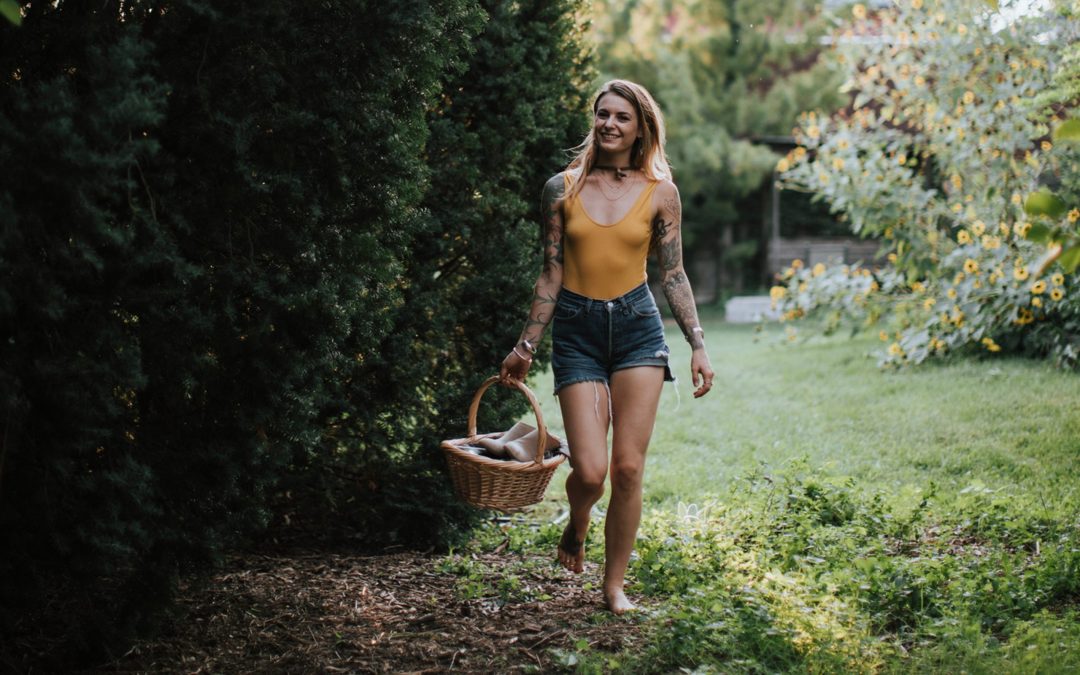Sattva: The Ayurvedic Way To Live Well
Our Wellbeing Director-at-Large, Eminé Kali Rushton, and her husband, Contributing Editor Paul Rushton, share an extract from their new conscious living book, 'Sattva: The Ayurvedic Way To Live Well' – and reflect on the journey that has brought them, and their family, back to a gentler way of living

Spiritual awakenings come with different levels of urgency. If we’re lucky, it will be like the emerging brightness on a Sunday – the sharpening birdsong gently calling us into newness and awareness, deliciously slowly and with perfect ease, like the sun or the rise of a good loaf. Sometimes, we’re jolted awake. Things happen suddenly and painfully to reveal the extent to which we’ve drifted from spiritual health, or to remind us that our spirit was even there in the first place.
Consciously unconscious
Paul and I deepened our interest in Ayurveda nine years ago, shortly after conceiving our first child. We’d long leaned towards conscious living; we busied ourselves with sourcing organic, Fairtrade food, coffee and clothing; buying household products and cosmetics without mineral or uncertified palm oils; offsetting our paper and vapour trails… while helpful and important in our modern context, sometimes these things can also seem a little abstract, striking somewhere shy of the heart of the matter.
We were, back then, without even realising it, walking back home to nature, baby step by baby step. We learned – as Ayurveda has always known – that the world we live in closely mirrors our own selves. And because we’re inextricable, whenever we seek to remove ourselves from nature – and our own nature: our calling, our purpose, our dharma – we feel deeply sad, isolated and increasingly desperate.
We believe that almost everybody will relate to that feeling of having to swim against the self – when we ignore our gut instincts, and push ourselves into situations where we feel blocked; or when we awake in cold, uninviting darkness and stay plugged in long after dusk. In our home, the windows were always closed against the dust, drone and blether of the road; the blinds against the blinking lights. The weather, the seasons, the celestial cycles were all just things going on outside that we might briefly enter on the walk to the bus stop or train station. Like so many, we were detached from nature and struggling to explain, quantify or justify the isolation, unhappiness and anxiety we felt. Paul broke down entirely.
Sleep, wake, eat, repeat
Work that was at first rewarding became heartbreaking and almost impossible. The simplest things grew difficult – sleeping, waking, eating, talking. The lights went out for a time. Around us, herbs struggled in pots on the little balcony overlooking the busy, polluted, ill-tempered road below – our daily soil was too poor to support us. We’d chosen the buzz of the city; access to work opportunities that did not exist outside; snippets of community found in passing, in work colleagues and in our phones. There was a reason why we felt drawn, almost daily, to the long walk that took us into the heart of London’s Greenwich Park, where we’d sit surrounded by old cedars and sweet chestnuts and never want to leave. We felt at ease there – as we all do in our parks and gardens, forests and fields, where sattva – purity, goodness – abounds. We fought a losing battle for peace with the cortisol flooding our system with every siren, almost here, almost gone; each adrenalised workday and impatient traffic at all hours. The reasons for the darkest of times can be incredibly elusive, contained as they often are in shadowy corners of our selves. Like everybody else, we were always logged on. Our working situations rendered us unable to be unavailable (or so we told ourselves); while we became increasingly so to the world outside of work.
Only disconnect
There’s a loneliness to modern urban living and our social mobility. While we exist quite apart from all other species (and more so from one another and our sense of community), we’re ostensibly more connected than ever. While physically apart, we’re not allowed that exquisite experience of missing someone, or even leaving someone behind. We carry one another in our pockets: our families and friends in this hemisphere or the other. Each affirmation we receive in this way, each alert telling us that our updates are approved of, brings an unsustainable spike in our dopamine levels, the likes of which our ancestors could never have imagined. Chemically, these encounters can be more interesting, more dramatic, than our ‘real life’ interactions, and we become lost in them, along with everybody else in our train carriage (which now has decent Wi-Fi to boot).
The same is true of much processed food and the to and fro between wanting and acquiring. A lot of undue rising and dipping that, in evolutionary terms, we’ve only recently had to contend with and are not equipped to handle well. Where our ancestors entered fight-or-flight mode, shutting down all but the most vital human functions in order to send a flood of energy towards fleeing across the desert or doing battle with immediate threats to their lives, we do the same at the cancellation of a train, a hard word from a work colleague or our misplaced keys; at the drop of a hat. Such emergency functions, now integrated incongruously into our day-to-day lifestyles, are what we call stress. At the end of the day, and the beginning, we were just two people in a box on the high road, overly wired and increasingly tired; we were self-medicating these unquantified factors and travelling to work in a bubble.
Physical birth and spiritual rebirth
This is real life, depending on who you’re talking to: a little disharmony, but nothing wrong. Unable to get our slow, graceful rise off the ground, we awoke instead with a bump. While preparing for our baby’s arrival, we were drawn to one book – Gowri Motha’s The Gentle Birth Method (HarperCollins, £16.99), the presiding wisdom of which was rooted in Ayurveda. This beautiful, intuitive, preparative approach jogged our memories of the snatches of Vedic and yogic practice we’d experienced; at once spiritual and immensely practical. The miracle of our first baby – that most fundamental magic – our world suddenly her world, her world newly ours, set us dreaming as we held her in a single palm, and we began to immerse ourselves in Ayurveda once more.
Returning to natural wisdom helped us to better understand our relationships with nature and with the modern world. There’s a unity and beautiful harmony to all of existence that runs converse to much of our modern context. When we live apart from nature, or any overarching sense of a connected whole, our days, actions, health and convictions can easily seem separate. Other people, other species, other places – all is division; painful and isolating.
New home, sweet home
Naturally, kindly, our baby daughter led us away from the city to the village; to a friendly terrace and a little cottage framed and flanked by woodland. A small community opened up to us, along with each of the seasons, the night sky and layer upon layer of life. The winter that had previously meant bigger coats and darker mornings became something more expansive: a shiver through the landscape; fine wood vapour from the village chimneys; that brittle shimmer to the grass underfoot which lights each tread. Every shift brought changes that our urban awareness had been unable to perceive – the introspection of autumn; the digestion and assimilation in the cold earth of winter; the new expression and cleansing of spring and the sheer, raucous vibrancy of summer. We began to grow food and flowers, which connected us further to the seasons, the earth and the elements. We began to feel quieted and somehow held.
We found our home in the big picture – one that made sense, one that put a lot of the petty stuff into perspective, at last. The moon, now much more visible, looming over the ancient conifers that hide our cottage from the road, also felt more present and relevant. We felt more involved in her cycling – thoughtful and quieter when she began to wane; more determined and replete in her fullness. We became aware of something that we’d rarely felt since childhood – nature’s ever-shifting, adjusting and balancing rta: its rhythm. There are entire, subtle symphonies of sound in our natural world – birdsong and bee hum – that we’d forgotten. We felt, so keenly, how we’d allowed our lives to become so disconnected from these subtleties as to become discordant. While nature shifted key innumerable times each and every day, we’d spent years missing it all. The life we’d previously chosen had no harmony, and no rhythm. What we had, really, was a full calendar year of white noise – filtered, centrally heated and air-conditioned. We ate the same stuff, day in, day out; we walked along the same road, caught the same train, sat in the same seat, and forgot to stare out of the window at all.
Living our truth
Today, we’re a family of four and busier than ever; we’re of modest means and poor on time, yet we incongruously feel that the pressure is off. With more subtlety and less volume, our shoulders dropped and the anxiety ebbed, Ayurveda now makes experiential sense. At its root is sattva – ‘sat’ means truth in Sanskrit, and to live our truth as human beings – aligned and harmonised, balanced and well – is our birthright. Sattva is life’s sweet spot – it is light, love, acceptance and peace. It is what life feels like when we remember that we are nature. Unease and ill health are simply the distance we fly from Mother Nature and her embracing, protecting and healing principles. And, for us, living what we’ve lived, and feeling what we’ve felt, we know that even one step removed is a step too far.
Extract from ‘SATTVA: The Ayurvedic Way To Live Well’ by Eminé and Paul Rushton (Hay House, £12.99). You can learn more about Ayurveda and ‘sattva’ by listening to Eminé and Paul’s podcast, This Conscious Life, and at their blog thisconsciouslife.co
Image: Getty Images






